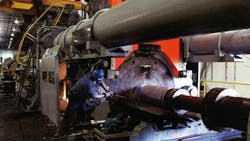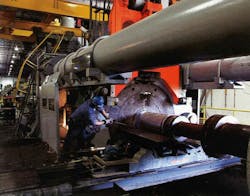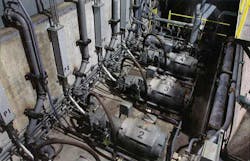A Part of History
Originally, the 14,000-ton water-hydraulic horizontal three-stage extrusion press was used mainly to extrude magnesium and aluminum aircraft components. One of the stories UAC has heard is that this press made aluminum skins for V-1 rockets, but the company officials don't know for certain if that ever happened.
After WW2, the press was shipped from Germany to the U.S., as part of a U.S. Air Force heavy press program. The press was acquired by Dow Chemical Corp. and reassembled in Madison, Ill., where it was used to extrude magnesium alloys mainly for aircraft and missiles. Its third owner was Spectrulite Consortium, St. Louis, which used the press to produce aluminum and magnesium extrusions. In 2003, UAC purchased the press rights from Spectrulite with the goal of expanding its aerospace business. In addition to the new press, the UAC facility in Canton operates four extrusion presses ranging from 900 to 2750 tons.
Hydraulic Overhaul
In direct extrusion, a heated tool container that encloses a billet (the raw piece of metal used for rolling into bars, rods and sections) is fixed in relation to a die during the extrude cycle. Approximately 50% of press tonnage is lost, due to a backflow condition that occurs in the tool container. In indirect extrusion, the tool container moves along with the press, over the die. With this process, only 20% of tonnage is lost to container friction, resulting in higher cycle speeds. However, press speeds (in tonnage) increase four times with indirect extrusion. This challenges the hydraulic designer on a big press to have accurate flow controls at both ends of the spectrum.
The Bosch Rexroth Hydraulics Systems and Engineering Group, in Bethlehem, Pa. provided the hydraulics package for the press, as well as the direct and indirect shears and two stretchers. The package included five hydraulic systems, piping and field startup assistance. The hydraulic systems consist of:
- 17,000-gal main reservoir,
- 1000-gal water/glycol reservoir,
- 60-gal unit run-out saw reservoir,
- 850-gal, 1500 ton stretcher reservoir, and
- 1200-gal, 350 ton stretcher reservoir.
Paul Scaglione, UAC vice president of engineering, explained that the hydraulics conversion was important to meet requirements for the next 20 years. "There were unique challenges in the conversion," said Scaglione. "We had to build the 'Swiss Army Knife' that could run direct extrusions, indirect extrusions, and seamless hollows. We also had to be concerned with the large amount of hydraulic operation above and around the heated tooling at the front platen."
The tooling is heated to 800° F, including the heated container that weighs 50 tons — a large mass operating above the flash point for conventional hydraulic oil. The original water press fluid was fireproof, as is the water-glycol now used.
Big hydraulics
Jim Lane and Otto Weber, systems engineers for Bosch Rexroth, worked closely with UAC to design multiple hydraulic systems for the massive press. The package included a huge 17,000-gal hydraulic system — featuring a reservoir, pilot system, motor pump groups, and manifolds.
Each of two prefill tanks is a 12,000-gal air-over-oil low pressure accumulator. Prefill tanks flow up to 7600 gpm and are charged to approximately 60 psi. Four main pumps have an output of up to 600 gpm at 4500 psi, while a container strip pump can achieve 8000 psi.
The extrusion rams advance 4.7 in./sec, and return at 4.5 in./sec. The main ram has an impressive 65-in. bore and 13.4-ft stroke. Two lateral rams have 48-in bores and 13.4-ft strokes, while two return rams feature 16-in. bores and the same stroke.
The four main pumps, which operate the extrusion cylinders, are Bosch Rexroth variable displacement servo-controlled pumps. Each has a design flow of 150 gpm. The system includes both closed-loop speed and pressure control.
The system also uses a Bosch Rexroth proportional directional control valve to control fast advance velocity, as well as acceleration and deceleration of the press. (Only minor velocity adjustments are made once extrusion starts.) The valve is used as a meter-out flow control when the press fast advances, using the pressurized prefill tanks. Flow exiting the return rams during fast advance is about 520 gpm.
A complete complement of logic valve technology is used for system fluid management. Variable displacement pumps and/or proportional valves reduce shock when the press accelerates or decelerates and also control velocity. Logic valves provide directional control and safety interlocks on circuits with large flows. Bosch Rexroth logic valves are rated for operation at up to 14,500 psi. The valves control the stripping function of the press, up to 8000 psi.
Handling the billet and die
According to Lane, billet and die handling on the press is aided by a 1000-gal water/glycol hydraulic system that operates at 4500 psi on the hot side of the press.
First, a die slide moves heavy dies into the press. A lock then secures the die in the press, and lift cylinders lift a butt catcher into position. (A butt is the unextruded portion of the billet remaining in the container after the extrusion cycle is completed.) A butt eject cylinder pushes the butt into the butt catcher, and swivel cylinders move the butt catcher into and out of the press. Direct and indirect shears (also hydraulically operated) are used to cut the extruded part from the butt. Hydraulics also operate the die slide, which is used to load dies for different shapes into the press.
Clamp, cut, stretch
Additional systems in the extrusion press overhaul include a 60-gal hydraulic power unit and manifold to control the clamping and feed of the large run-out saw used to cut extrusions coming off the press. The aluminum part to be cut is clamped, and an adjustable feed controls the saw blade advance.
An 850-gal hydraulic system with reservoir, motor pump groups and manifolds was provided to drive the 1500- ton stretcher used to further process the extrusions. A stretcher is a device that holds both ends of a part and pulls that part a prescribed amount. The stretcher heads rotate so that a part can be twisted while under stretch. This is done to remove twist that occurs on the press or after heat treat.
After heat treating, the aluminum extrusions are elongated by 2-3%. The parts are grabbed by the jaws in the stretcher, and pressure is applied to accomplish elongation.
A custom-designed prefill adapter was also added to allow mounting of the prefill valves in limited space and permit high-speed advance and return of the stretcher. A prefill valve is nothing more that a giant pilot-operated check valve. They are so massive on presses, that they generally have two pilot stages to open. They prefill the large cylinders with low-pressure oil as the press advances. Then they shift to block off low pressure and allow high pressure to perform the work.
On the press, the cylinders are filled with 6800 gal of oil from the reservoir before the prefill closes, and tonnage is applied to the press. Prefill valves are a conservation device, allowing the pumps to work on small advance cylinders for press movements at higher speed until full tonnage is needed.
On the 1500-ton stretcher, no prefill is needed on the end of the main cylinder. In the original water press schematic, the prefill valve was contained in a valve block that was scrapped with the original water press hydraulic system. It was too small for UAC's application, so a new valve was necessary. Unfortunately, there was not a lot of room for the new valve. Rexroth had a low-profile prefill, but it needed a custom adapter in order to be placed on the end of the main cylinder.
Likewise, cylinders specially designed to fit in the existing stretcher frame were provided for the fast advance and return (10 in./sec) functions of the stretcher. The original German water presses used single acting cylinders, so the tonnage cylinders advanced the press (or stretcher in this case), and smaller single-acting cylinders — called pullbacks — retracted the press. To convert this stretcher to oil hydraulics, UAC and Bosch replaced the single-acting pullbacks with custom-built double-acting cylinders. This had a side benefit of adding in to the tonnage effort and help boost overall capacity.
Two cylinders are on the stretcher, each with a 6-in. bore and 4.5-in. rod. Fast advance (or retract) occurs when the new cylinders alone move the stretcher head (prefill open).
Finally, rounding out the hydraulics package is a 1200-gal hydraulic system, including reservoir, pilot system, motor pump groups, and manifolds to drive the press's 350-ton stretcher. (The 850-ton and 350-ton stretchers are located across a bay from each other, this is why there are two different reservoirs). This 350 ton stretcher will be used on 80% of the material that flows from the big press. Even though it has a smaller capacity, it will be more highly used and, therefore, has higher flow rates to keep up with the metal exiting heat treating.
An overall success
The company wanted to operate the press approximately 18 months from the purchase order date. To help the transition, UAC hired the maintenance manager from the Spectrulite Consortium in St. Louis. "He relocated with the press, so he has the unique experience of seeing the before and the after," noted Scaglione. "In the first six months of operation there have been no major leaks, no stuck valves, and no hydraulic problems of any sort. The most he's had to do is change a couple of O-rings."
Scaglione added, "I liked Bosch Rexroth's capability for effective horsepower limiting. In building a new plant for the heavy press, we received new transformers from the local utility company. Those had to be custom-sized to match the plant's connected load. The bigger the transformers, the higher our initial cost, as well as operating costs later on. In theory, we needed 3000 hp just for hydraulics.
"When Universal Alloy did the math on motor sizing without horsepower limiting, we needed 500 hp times four on the press alone. Horsepower limiting enabled the same pumps to run on 350-hp motors with no loss in performance. The smaller motors use less amps for starting and operation. Horsepower is a function of flow and pressure. We can have full flow at low pressure that allows high speed press advance. And we reduced flow at high pressure, which has very little effect on metal production."
"Our company is very cost sensitive," said Scaglione. "None of the change orders were out of line, and we had such a great startup that we used only about 30% of the service budget allocated to the project."
About the Author

Leaders relevant to this article:


